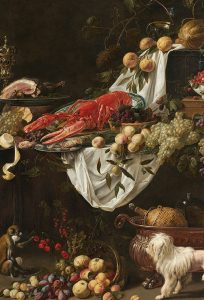Image by Adriaen van Utrecht/Rijksmuseum
Dear writers, readers and friends,
As you well know, our modus operandi at Visual Verse is to run a continual cycle of commissioning and publishing in order to reflect what’s happening in the world. Over the past decade your writing, imbued in our unique journal, has reflected many of the key moments in modern history: Trump’s rise, climate action, natural disasters, wars, global anti-racism activism, #metoo and now… the rise of AI.
So of course, we had to feature the most prolific up-and-coming writer of the moment – none other than ChatGPT (https://openai.com/blog/chatgpt) . The headlines would have us believe that this viral AI bot has writing skills so sophisticated we’ll all be obsolete tomorrow. We needed to see for ourselves.
I experimented with the bot over several days, using multiple images and dozens of commands. The results ranged from irrelevant (“Are you writing to the image I gave you? That description doesn’t sounds like it.”) to Hallmark greeting card (So let us not strive for perfection alone, But embrace the flaws that make us our own) and it seems to be very keen on rhyme (“write a poem between 50-500 words in response to X image” “Write it again but as a non-rhyming poem” “you’re still using rhyme, please rewrite again but with NO RHYMING” “why are you still rhyming, do you know what rhyming is?” and so on…). Finally, at 11pm on March 1st (Melbourne time) I got a poem that didn’t rhyme. As you can see from page 1, the final command “Please rewrite in the style of Samuel Beckett” produced a sub-par poem in the name of a legend for which I’m sure he is turning in his grave.
There are four things I’ve learned from working with ChatGPT:
There is craft in the command. For better or worse, getting a poem out of AI is a collaborative process and it forced me to think differently. It is not easy to yield a good poem, and it is clear we are still the ultimate authors of this technology, at least for poetry.
AI can write a poem but it can’t replace the poet. It can’t turn up to a meeting with a publisher and secure a book deal. It can’t sit in a low-lit pub reading poems to a captive audience. It can’t bring the humanity suffused in art. It can’t exist off-line. We can.
There is more to us than we know. We know relatively little about the human brain, so perhaps the proliferation of AI will force us creatives to go deeper into our own intelligence. Our unconscious minds are full of wonder and surprise – as our ekphrastic challenge shows each month – and I feel somewhat hopeful that writers, artists and the entrepreneurial minds will find their way to discovering more of their potential, not less.
If ever there is a time to put your work into the world it is now. AI feeds off the words, ideas and content that we – the humans – have put out there. Our talents and knowledge as artists and writers needs to be present and vocal during this transition. Our voices as a diverse and inclusive community need to be louder than ever. ChatGPT is riddled with stereotypes (as a crude example, try asking it to produce a poem that appeals to men, then a poem that appeals to women, and you’ll see what I mean) and we need to be speaking up and publishing more to ensure our DNA goes into the new life forming around AI.
As a publication, we have not yet formed an opinion about AI. We are watching, reading and talking as the topic unfolds. Personally, I am cautiously curious and this lead piece is presented not as an endorsement but as a call to action. Let’s us write more, better and louder.
It’s over to you, dear humans. We offer you a rich and wondrous still life dating back to 1631 by Adriaen van Utrecht (courtesy of the Rijksmuseum, Amsterdam) and look forward to receiving your responses. It’s OK if they rhyme, by the way, just not every line please. That’s a command.
The image is the starting point, the text is up to you.
Kristen
with Preti, Isabel, Lucie, Ashish, Zaynab and Wes White

